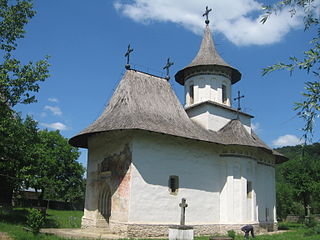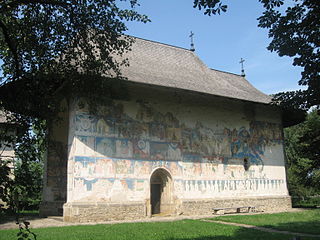
The National Register of Historic Monuments (Romanian: Lista Monumentelor Istorice (LMI)) is the official English name of the Romania government's list of national heritage sites known as Monumente istorice. In Romania, these include sites, buildings, structures, and objects considered worthy of preservation due to the importance of their Romanian cultural heritage. The list, created in 2004, contains places that have been designated by the Ministry of Culture and National Patrimony of Romania and are maintained by the Romanian National Institute of Historical Monuments, as being of national historic significance.

The Tecuci Town Museum was established in Tecuci, Romania in 1932 based on the private collections of Mihail Dimitriu and Constantin Solomon, in a building donated by Teodor Cincu.
The fort was part of the defensive system of the Roman province of Dacia in the 2nd and 3rd centuries AD. The ruins of a contemporary nearby defensive ditch was also unearthed. It is located in Abrud (Romania).

Morisena was a castra in the Roman province of Dacia. Morisena was a Roman auxiliary camp and part of the outline in the western fortress chain of the Dacian Limes. It was located within the modern municipality of Cenad, Romania.
The castra of Poiana was a fort in the Roman province of Dacia near the present town of Poiana. It was built in the 2nd century AD and abandoned in the next century. It was a part of the Limes Transalutanus frontier system and situated at the southern end next to the Danube.

The Castra of Ighiu was a fort made of earth in the Roman province of Dacia. Its dating is uncertain. The traces of the earthwork can be identified on the Măguligici Hill in Ighiu (Romania).
It was a fort in the Roman province of Dacia and part of the Roman frontier system of the Limes Transalutanus.
The castra of Crâmpoia was a fort in the Roman province of Dacia. It was made of earth in the 2nd century AD. The Romans abandoned the fort in the 3rd century. Its ruins are located in Crâmpoia, Romania.
The castra of Costești was a fort in the Roman province of Dacia. Erected and abandoned by the Romans at an uncertain date, its ruins are located in Costești on a hilltop, at an altitude of 1203 meters.

Gresia Roman fort is located in the present Gresia. It was in the Roman province of Dacia and dates from the 2nd and 3rd centuries AD. It was part of the frontier system of the Limes Transalutanus.
The castra of Livezile was a castra in the Roman province of Dacia, located in the north side of the modern commune of Livezile in the historical region of Transylvania, Romania. The fort was erected and surrounded by a ditch in the 2nd century AD. The castra was abandoned in the 3rd century and its ruins are still visible.
The castra of Războieni-Cetate was a fort in the Roman province of Dacia.

The Cluj County Prefecture is a building in Cluj-Napoca, Romania, housing the offices of the Cluj County prefect. It is located at 21 Decembrie 1989 Boulevard, nr. 58.

Saint Parascheva Church is a Romanian Orthodox church in Desești Commune, Maramureș County, Romania. Built in 1770, it is one of eight buildings that make up the wooden churches of Maramureș UNESCO World Heritage Site, and is also listed as a historic monument by the country's Ministry of Culture and Religious Affairs.

The Church of the Archangels Michael and Gabriel is a Romanian Orthodox church in Plopiș village, Șișești Commune, Maramureș County, Romania. Built in 1798, it is one of eight buildings that make up the wooden churches of Maramureș UNESCO World Heritage Site, and is also listed as a historic monument by the country's Ministry of Culture and Religious Affairs.

Saint Parascheva Church is a Romanian Orthodox church in Poienile Izei Commune, Maramureș County, Romania. Built in 1700, it is one of eight buildings that make up the wooden churches of Maramureș UNESCO World Heritage Site, and is also listed as a historic monument by the country's Ministry of Culture and Religious Affairs.

The Church of the Archangels Michael and Gabriel is a Greek-Catholic church in Șurdești village, Șișești Commune, Maramureș County, Romania. Built in 1721, it is one of eight buildings that make up the wooden churches of Maramureș UNESCO World Heritage Site, and is also listed as a historic monument by the country's Ministry of Culture and Religious Affairs.

Probota Monastery is a Romanian Orthodox monastery in Probota village, Dolhasca town, Suceava County, Romania. Built in 1530, with Peter IV Rareș as ktitor, it is one of eight buildings that make up the Churches of Moldavia UNESCO World Heritage Site, and is also listed as a historic monument by the country's Ministry of Culture and Religious Affairs.

The Church of the Elevation of the Holy Cross is a Romanian Orthodox church in Pătrăuți Commune, Suceava County, Romania. Built in 1487, with Stephen III of Moldavia as ktitor, it is one of eight buildings that make up the churches of Moldavia UNESCO World Heritage Site, and is also listed as a historic monument by the country's Ministry of Culture and Religious Affairs.

The Arbore Church is a Romanian Orthodox monastery church in Arbore Commune, Suceava County, Romania. Built in 1502 by Luca Arbore, and dedicated to the Beheading of St. John the Baptist, it is one of eight buildings that make up the churches of Moldavia UNESCO World Heritage Site. It is also listed as a historic monument by the country's Ministry of Culture and Religious Affairs.












